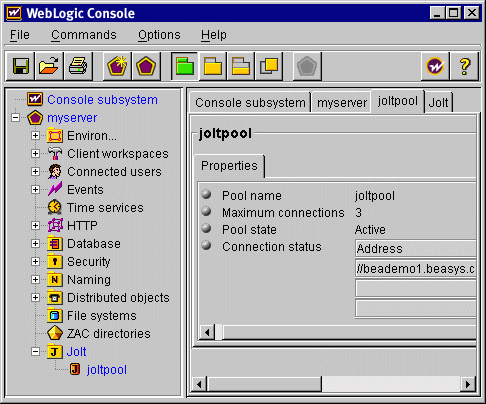


|

|
Setting up Jolt for WebLogic
BEA Jolt for WebLogic allows BEA TUXEDO services to be web-enabled
using the BEA WebLogic Server as its front end. Jolt is a Java API
that manages and allows requests to BEA TUXEDO services via a Jolt
Service Listener, running on the TUXEDO server. The Jolt API is
embedded within the WebLogic API and is accessible from a servlet,
JHTML, or any other WebLogic application. This Admin Guide describes
how to configure a Jolt session (connection) pool between TUXEDO and
WebLogic.
Configuring Jolt for TUXEDORefer to the Jolt documentation for instruction on setting up a Jolt Service Listener (JSL) within TUXEDO. This Administrators guide presumes that these services have already been configured within the TUXEDO domain, and only describes how to establish a session pool connection to them from WebLogic. Configuring Jolt for WebLogicThis section describes how to set up a BEA Jolt connection pool between the WebLogic Server and the JSL in the TUXEDO domain. Your WebLogic Server must have access to the host running the JSL. Jolt startup propertiesYou must instruct WebLogic to invoke the PoolManagerStartUp class, which will establish the pool connection to TUXEDO, from the weblogic.properties file as shown in the example below. The WebLogic Server will invoke the PoolManagerStartUp class when it is started, or restarted. weblogic.system.startupClass.joltpool=\
bea.jolt.pool.servlet.weblogic.PoolManagerStartUp
weblogic.system.startupArgs.joltpool=\
poolname=myJoltPool,\
appaddrlist=//tuxserver:8000;//tuxserver:9000,\
failoverlist=//tuxserver:9090,\
minpoolsize=1,\
maxpoolsize=3
These example properties are already included in the default WebLogic properties file, but they are commented out. You should find them, adjust them for your system configuration, and uncomment them, in order for them to take effect. You must then start (or restart) the WebLogic Server. The first property above instructs WebLogic to invoke the PoolManagerStartUp class when the WebLogic Server starts. The second property specifies initialization arguments that are passed to the PoolManagerStartUp class. These are defined as:
Jolt shutdown propertiesConfigure WebLogic to disconnect the Jolt session pools from TUXEDO when it shuts down by adding the following lines to the WebLogic properties file (or uncommenting the appropriate lines if they already exist). weblogic.system.shutdownClass.joltapp=\
bea.jolt.pool.servlet.weblogic.PoolManagerShutDown
weblogic.system.shutdownArgs.joltapp=\
poolname=myJoltPool
where
Jolt for WebLogic in the ConsoleJolt for WebLogic connections are also displayed in the WebLogic Console. Start the Console. If you connect to a Weblogic Server that has Jolt correctly configured you will see a ManagedObject for the Jolt connection pool:

Server with Jolt connection pool For each Jolt connection pool there is an individual ManagedObject which displays the pool name, maximum connections, pool state, and statistics about the connection status. Try the Jolt servlet examplesWe ship several Jolt for WebLogic examples, in the examples/jolt/servlet directory of the distribution. Instructions for running the examples are included in each example directory.Contacting BEA customer supportIf you have questions about this version of Jolt for WebLogic or if you have problems installing or running the classes, please contact BEA customer support through BEA Websupport. You can also contact customer support by using the contact information provided on the Customer Support Card included in the product package.When contacting customer support, be prepared to provide the following information:
|
|
|
|
Copyright © 2000 BEA Systems, Inc. All rights reserved.
|